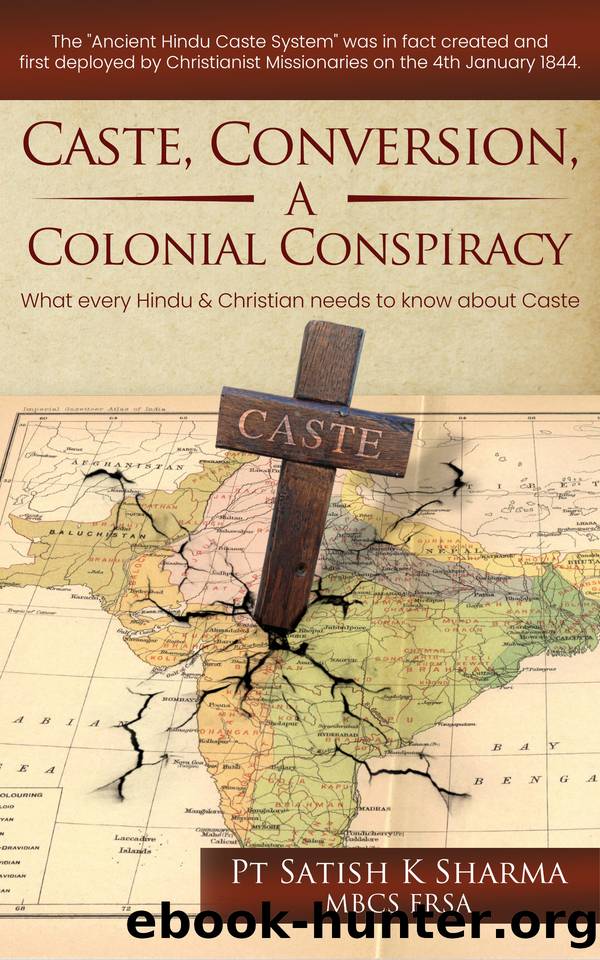Caste, Conversion A Colonial Conspiracy: What Every Hindu and Christian must know about Caste by K Sharma Pt Satish

Author:K Sharma, Pt Satish [K Sharma, Pt Satish]
Language: eng
Format: epub
Publisher: BBDS Publishing
Published: 2021-02-10T00:00:00+00:00
Caste, Varna, Jati & Kul
A s to âCasteâ â It first appears in mid-16th century Europe (in the general sense of ârace, breedâ): from the Spanish and Portuguese casta âlineage, race, breedâ, feminine of casto âpure, unmixedâ, from Latin castus âchasteâ. Modern day Caste is defined as having three attributes â âhierarchical, endogamous & hereditaryâ, and was the word describing the Portuguese and European social structure of Pope/Cardinals, Aristocracy, Merchants and âPeasantsâ. There is no equivalent word or concept in the Hindu Scriptures and no identical structure either recorded or promoted in Hindu Scriptures. Caste is simply Portuguese for âSocial Classâ
As to âVarnaâ - This is a Sanskrit word which means âtype, order, colour or class.â It more precisely means âvariations/variety, choice from a varied selection.â As in Varmala â the Garland of choice used by a Hindu Princess at her SwayamVar (âself choiceâ) to declare to all her chosen suitor, the Varnmala ie the alphabet â a garland of variations ie different sounds. Var like so many Sanskrit roots has found its way into English as in variation and variety.
In the context of the often deliberately and unknowingly misquoted core Hindu Scripture the Bhagavad Gita, Sri Krishna says âI have created 4 variations of person â the intellectual, the warrior, the trader and the labourerâ. There is no connection in the verse quoted with hereditary, no mention of hierarchy and no connection with endogamy. Indeed there are verses clearly denying the hereditary and hierarchical claims. Varna clearly does not mean a hereditary, hierarchical, endogamous social class structure, which is what the word âcasteâ means.
Sri Aurobindo, one of Indiaâs greatest Hindu saints recorded âThe spirit of ancient India was aristocratic; its thought and life moulded in the cast of a high and proud nobility, an extreme and lofty strenuousness. The very best in thought, the very best in action, the very best in character, the very best in literature and art, the very best in religion and all the world well lost if only this very best might be attained, such was the spirit of ancient India. The Brahmin who devoted himself to poverty and crushed down every desire in the wholehearted pursuit of knowledge and religious self-discipline; the Kshatriya who, hurling his life joyously into the shock of chivalrous battle, held life, wife, children, possessions, ease, happiness as mere dust in the balance compared with honour and the Kshatriya dharma, the preservation of self-respect, the protection of the weak, the noble fulfilment of princely duty; the Vaishya, who toiling all his life to amass riches, poured them out as soon as amassed in self-forgetting philanthropy, holding himself the mere steward and not the possessor of his wealth; the Shudra who gave himself up loyally to humble service, faithfully devoting his life to his dharma, however low, in preference to self-advancement and ambition; these were the social ideals of the ageâ. This was the Hindu India the British discovered.
Historically, in India, just as in any nation anywhere in the world
Download
This site does not store any files on its server. We only index and link to content provided by other sites. Please contact the content providers to delete copyright contents if any and email us, we'll remove relevant links or contents immediately.
| Anglican | Baptist |
| Book of Common Prayer | Calvinist |
| Episcopalian | Inspirational |
| Lutheran | Methodist |
| Pentecostal & Charismatic | Presbyterian |
| Quaker | Seventh-Day Adventist |
| Shaker | Theology |
Angels by Billy Graham(1906)
How To Be Born Again by Billy Graham(1759)
Peace with God by Billy Graham(1663)
Unbroken Curses by Rebecca Brown & Daniel Yoder(1548)
God's Prophetic Symbolism in Everyday Life by Adam Thompson & Adrian Beale(1467)
The School of Biblical Evangelism by Ray Comfort(1415)
Call by Rick Joyner(1397)
Martin Luther: The Man Who Rediscovered God and Changed the World by Eric Metaxas(1377)
Power over the Enemy by John Osteen & Joel Osteen(1326)
Fresh Wind, Fresh Fire by Jim Cymbala(1216)
Jonathan Edwards: A Life by Marsden George M(1214)
Prayers That Bring Healing and Activate Blessings: Experience the Protection, Power, and Favor of God by John Eckhardt(1205)
Liturgy of the Ordinary by Tish Harrison Warren(1193)
The Supernatural Power of a Transformed Mind Expanded Edition: Access to a Life of Miracles by Bill Johnson(1188)
Unmasking the Devil: Strategies to Defeat Eternity's Greatest Enemy by John Ramirez(1178)
An Altar in the World by Barbara Brown Taylor(1171)
Reformation Theology by Littlejohn Bradford(1164)
Martin Luther by Mansch Larry D.; Peters Curtis H.;(1122)
Seeing the Voice of God: What God Is Telling You through Dreams and Visions by Smith Laura Harris(1119)
